Study of a Novel Updraft Tower Power Plant Combined with Wind and Solar Energy
Abstract
:1. Introduction
2. Experimental System and Model Development
2.1. Experimental System
2.2. Model Development
2.2.1. Model Assumptions
- (1)
- The airflow inside the collector and the tower can be regarded as an incompressible flow, and the Boussinesq hypothesis is applicable to this system.
- (2)
- The non-uniform heating of the collector surface in terms of the solar altitude angle is neglected.
- (3)
- The energy storage layer is not included in the SUTPP system because it can be neglected in the steady-state simulation.
- (4)
- Radiation models are not used because the radiation heat transfer inside the collector and tower is small compared with the conduction and convection.
- (5)
- The collector efficiency is not considered.
2.2.2. Governing Equations
2.2.3. Boundary Conditions
2.2.4. Solution Method
3. Results and Discussion
3.1. Model Validation
3.2. Experimental Results
3.2.1. Effects of Solar Radiation
3.2.2. Effects of Ambient Wind Speed
3.3. Numerical Results
3.3.1. Temperature Rise at Tower Inlet
3.3.2. Air Velocity at Turbine Inlet
3.3.3. Output Power
4. Conclusions
Author Contributions
Funding
Data Availability Statement
Conflicts of Interest
References
- Abdelsalam, E.; Almomani, F.; Azzam, A.; Juaidi, A.; Abdallah, R.; Shboul, B. Synergistic energy solutions: Solar chimney and nuclear power plant integration for sustainable green hydrogen, electricity, and water production. Process Saf. Environ. Prot. 2024, 186, 756–772. [Google Scholar] [CrossRef]
- Mehranfar, S.; Gharehghani, A.; Azizi, A.; Mahmoudzadeh Andwari, A.; Pesyridis, A.; Jouhara, H. Comparative assessment of innovative methods to improve solar chimney power plant efficiency. Sustain. Energy Technol. Assess. 2022, 49, 101807. [Google Scholar] [CrossRef]
- Das, P.; Chandramohan, V.P. A review on solar updraft tower plant technology: Thermodynamic analysis, worldwide status, recent advances, major challenges and opportunities. Sustain. Energy Technol. Assess. 2022, 52, 102091. [Google Scholar] [CrossRef]
- Saleh, M.J.; Atallah, F.S.; Algburi, S.; Ahmed, O.K. Enhancement methods of the performance of a solar chimney power plant: Review. Results Eng. 2023, 19, 101375. [Google Scholar] [CrossRef]
- Das, P.; Chandramohan, V.P. A review on recent advances in hybrid solar updraft tower plants: Challenges and future aspects. Sustain. Energy Technol. Assess. 2023, 55, 102978. [Google Scholar] [CrossRef]
- Belkhode, P.; Sakhale, C.; Bejalwar, A. Evaluation of the experimental data to determine the performance of a solar chimney power plant. Mater. Today Proc. 2020, 27, 102–106. [Google Scholar] [CrossRef]
- Onyango, F.N.; Ochieng, R.M. The potential of solar chimney for application in rural areas of developing countries. Fuel 2006, 85, 2561–2566. [Google Scholar] [CrossRef]
- Kasaeian, A.B.; Molana, S.; Rahmani, K.; Wen, D. A review on solar chimney systems. Renew. Sustain. Energy Rev. 2017, 67, 954–987. [Google Scholar] [CrossRef]
- Zhou, X.; Yang, J.; Xiao, B.; Shi, X. Special Climate around a Commercial Solar Chimney Power Plant. J. Energy Eng. 2008, 134, 6–14. [Google Scholar] [CrossRef]
- Al-Kayiem, H.H.; Aja, O.C. Historic and recent progress in solar chimney power plant enhancing technologies. Renew. Sustain. Energy Rev. 2016, 58, 1269–1292. [Google Scholar] [CrossRef]
- Haaf, W.; Friedrich, K.; Mayr, G.; Schlaich, J. Solar Chimneys Part I: Principle and Construction of the Pilot Plant in Manzanares. Int. J. Sol. Energy 1983, 2, 3–20. [Google Scholar] [CrossRef]
- Schlaich, J. Solar Chimney: Electricity from the Sun. 1996. Available online: https://www.semanticscholar.org/paper/Solar-Chimney%3A-Electricity-from-the-Sun-Schlaich/7faff4a4b0cd375de3bd87802d59672afbed1e2f?utm_source=direct_link (accessed on 3 August 2024).
- Schlaich, J.; Schafer, K.; Jennewein, M. Toward a consistent design of structural concrete. PCI J. 1987, 32, 74–150. [Google Scholar] [CrossRef]
- Zhou, X.; Wang, F.; Ochieng, R.M. A review of solar chimney power technology. Renew. Sustain. Energy Rev. 2010, 14, 2315–2338. [Google Scholar] [CrossRef]
- Sundararaj, M.; Rajamurugu, N.; Anbarasi, J.; Yaknesh, S.; Sathyamurthy, R. Parametric optimization of novel solar chimney power plant using response surface methodology. Results Eng. 2022, 16, 100633. [Google Scholar] [CrossRef]
- Pretorius, J.P.; Kröger, D.G. Critical evaluation of solar chimney power plant performance. Sol. Energy 2006, 80, 535–544. [Google Scholar] [CrossRef]
- Zhou, X.; Wang, F.; Fan, J.; Ochieng, R.M. Performance of solar chimney power plant in Qinghai-Tibet Plateau. Renew. Sustain. Energy Rev. 2010, 14, 2249–2255. [Google Scholar] [CrossRef]
- Saad, M.; Ahmed, N.; Mahmood, M.; Sajid, M.B. Performance enhancement of solar updraft tower plant using parabolic chimney profile configurations: A numerical analysis. Energy Rep. 2022, 8, 4661–4671. [Google Scholar] [CrossRef]
- Gholamalizadeh, E.; Chung, J.D. Analysis of fluid flow and heat transfer on a solar updraft tower power plant coupled with a wind turbine using computational fluid dynamics. Appl. Therm. Eng. 2017, 126, 548–558. [Google Scholar] [CrossRef]
- Balijepalli, R.; Chandramohan, V.P.; Kirankumar, K. Performance parameter evaluation, materials selection, solar radiation with energy losses, energy storage and turbine design procedure for a pilot scale solar updraft tower. Energy Convers. Manag. 2017, 150, 451–462. [Google Scholar] [CrossRef]
- Torabi, M.R.; Hosseini, M.; Akbari, O.A.; Afrouzi, H.H.; Toghraie, D.; Kashani, A.; Alizadeh, A.A. Investigation the performance of solar chimney power plant for improving the efficiency and increasing the outlet power of turbines using computational fluid dynamics. Energy Rep. 2021, 7, 4555–4565. [Google Scholar] [CrossRef]
- Keshari, S.R.; Chandramohan, V.P.; Das, P. A 3D numerical study to evaluate optimum collector inclination angle of Manzanares solar updraft tower power plant. Sol. Energy 2021, 226, 455–467. [Google Scholar] [CrossRef]
- Belkhode, P.N.; Shelare, S.D.; Sakhale, C.N.; Kumar, R.; Shanmugan, S.; Soudagar, M.E.M.; Mujtaba, M.A. Performance analysis of roof collector used in the solar updraft tower. Sustain. Energy Technol. Assess. 2021, 48, 101619. [Google Scholar] [CrossRef]
- Cuce, P.M.; Cuce, E.; Mandal, D.K.; Gayen, D.K.; Asif, M.; Bouabidi, A.; Alshahrani, S.; Prakash, C.; Soudagar, M.E.M. ANN and CFD driven research on main performance characteristics of solar chimney power plants: Impact of chimney and collector angle. Case Stud. Therm. Eng. 2024, 60, 104568. [Google Scholar] [CrossRef]
- Rezaei, L.; Saeidi, S.; Sápi, A.; Abdollahi Senoukesh, M.R.; Gróf, G.; Chen, W.-H.; Kónya, Z.; Klemeš, J.J. Efficiency improvement of the solar chimneys by insertion of hanging metallic tubes in the collector: Experiment and computational fluid dynamics simulation. J. Clean. Prod. 2023, 415, 137692. [Google Scholar] [CrossRef]
- Singh, A.P.; Singh, J.; Kumar, A.; Singh, O.P. Vertical limit reduction of chimney in solar power plant. Renew. Energy 2023, 217, 119118. [Google Scholar] [CrossRef]
- Eryener, D. Performance investigation of a solar updraft tower concept with downdraft windcatcher. Energy Convers. Manag. 2023, 286, 117055. [Google Scholar] [CrossRef]
- Praveen, V.; Chandramohan, V.P. Numerical study on optimization of fillet size on the chimney base of solar updraft tower plant for enhanced performance. Therm. Sci. Eng. Prog. 2022, 34, 101400. [Google Scholar] [CrossRef]
- Das, P.; Chandramohan, V.P. Computational study on the effect of collector cover inclination angle, absorber plate diameter and chimney height on flow and performance parameters of solar updraft tower (SUT) plant. Energy 2019, 172, 366–379. [Google Scholar] [CrossRef]
- Das, P.; Chandramohan, V.P. 3D numerical study on estimating flow and performance parameters of solar updraft tower (SUT) plant: Impact of divergent angle of chimney, ambient temperature, solar flux and turbine efficiency. J. Clean. Prod. 2020, 256, 120353. [Google Scholar] [CrossRef]
- Esmail, M.F.C.; A-Elmagid, W.M.; Mekhail, T.; Al-Helal, I.M.; Shady, M.R. A numerical comparative study of axial flow turbines for solar chimney power plant. Case Stud. Therm. Eng. 2021, 26, 101046. [Google Scholar]
- Xue, H.; Esmaeilpour, M. Power generation using solar energy: The effect of curved-guide vanes on the performance of a turbine in a solar chimney power plant. Sol. Energy 2022, 247, 468–484. [Google Scholar] [CrossRef]
- Balijepalli, R.; Chandramohan, V.P.; Kirankumar, K. Optimized design and performance parameters for wind turbine blades of a solar updraft tower (SUT) plant using theories of Schmitz and aerodynamics forces. Sustain. Energy Technol. Assess. 2018, 30, 192–200. [Google Scholar] [CrossRef]
- Bagheri, S.; Ghodsi Hassanabad, M. Numerical and experimental investigation of a novel vertical solar chimney power plant for renewable energy production in urban areas. Sustain. Cities Soc. 2023, 96, 104700. [Google Scholar] [CrossRef]
- Ali, M.H.; Kurjak, Z.; Beke, J. Modelling and simulation of solar chimney power plants in hot and arid regions using experimental weather conditions. Int. J. Thermofluids 2023, 20, 100434. [Google Scholar] [CrossRef]
- Esmail, M.F.C.; Khodary, A.; Mekhail, T.; Hares, E. Effect of wind speed over the chimney on the updraft velocity of a solar chimney power plant: An experimental study. Case Stud. Therm. Eng. 2022, 37, 102265. [Google Scholar] [CrossRef]
- Rushdi, M.A.; Yoshida, S.; Watanabe, K.; Ohya, Y. Machine learning approaches for thermal updraft prediction in wind solar tower systems. Renew. Energy 2021, 177, 1001–1013. [Google Scholar] [CrossRef]
- Zandian, A.; Ashjaee, M. The thermal efficiency improvement of a steam Rankine cycle by innovative design of a hybrid cooling tower and a solar chimney concept. Renew. Energy 2013, 51, 465–473. [Google Scholar] [CrossRef]
- Chen, Y.; Yang, Y.; Wei, Y. The Technology of Solar Heated Buoyancy driven flow Updraft Tower Power Plant and its Application in Wuhai desert of Inner Mongolia. Energy Res. Inf. 2010, 26, 117–121. [Google Scholar]
- Yang, Y.; Chen, Y.; Wei, Y. Experiments and CFD simulation of solar heated wind updraft tower power plant. J. Inn. Mong. Univ. Sci. Technol. 2010, 29, 62–65. [Google Scholar]
- Guo, P.; Wang, Y.; Li, J.; Wang, Y. Thermodynamic analysis of a solar chimney power plant system with soil heat storage. Appl. Therm. Eng. 2016, 100, 1076–1084. [Google Scholar] [CrossRef]
- Hasnain, S.M. Review on sustainable thermal energy storage technologies, Part I: Heat storage materials and techniques. Energy Convers. Manag. 1998, 39, 1127–1138. [Google Scholar] [CrossRef]
- Zhang, M.; Zhu, X.; Shi, J.; Liu, B.; He, Z.; Liang, C. Utilization of desert sand in the production of sustainable cement-based materials: A critical review. Constr. Build. Mater. 2022, 327, 127014. [Google Scholar] [CrossRef]
- Barzegar-Kalashani, M.; Seyedmahmoudian, M.; Mekhilef, S.; Stojcevski, A.; Horan, B. Small-scale wind turbine control in high-speed wind conditions: A review. Sustain. Energy Technol. Assess. 2023, 60, 103577. [Google Scholar] [CrossRef]
- Fuchs, F.W. Power Electronic Generator Systems for Wind Turbines; Springer Science and Business Media Deutschland GmbH: Berlin/Heidelberg, Germany, 2023; pp. 319–394. [Google Scholar]
- Hobbs, B.; Ord, A. Chapter 12—Fluid Flow. In Structural Geology; Hobbs, B., Ord, A., Eds.; Elsevier: Oxford, UK, 2015; pp. 365–421. [Google Scholar]
- Xu, G.; Ming, T.; Pan, Y.; Meng, F.; Zhou, C. Numerical analysis on the performance of solar chimney power plant system. Energy Convers. Manag. 2011, 52, 876–883. [Google Scholar] [CrossRef]
- Asnaghi, A.; Ladjevardi, S.M. Solar chimney power plant performance in Iran. Renew. Sustain. Energy Rev. 2012, 16, 3383–3390. [Google Scholar] [CrossRef]
- Zhou, X.; Yang, J.; Xiao, B.; Hou, G. Simulation of a pilot solar chimney thermal power generating equipment. Renew. Energy 2007, 32, 1637–1644. [Google Scholar] [CrossRef]
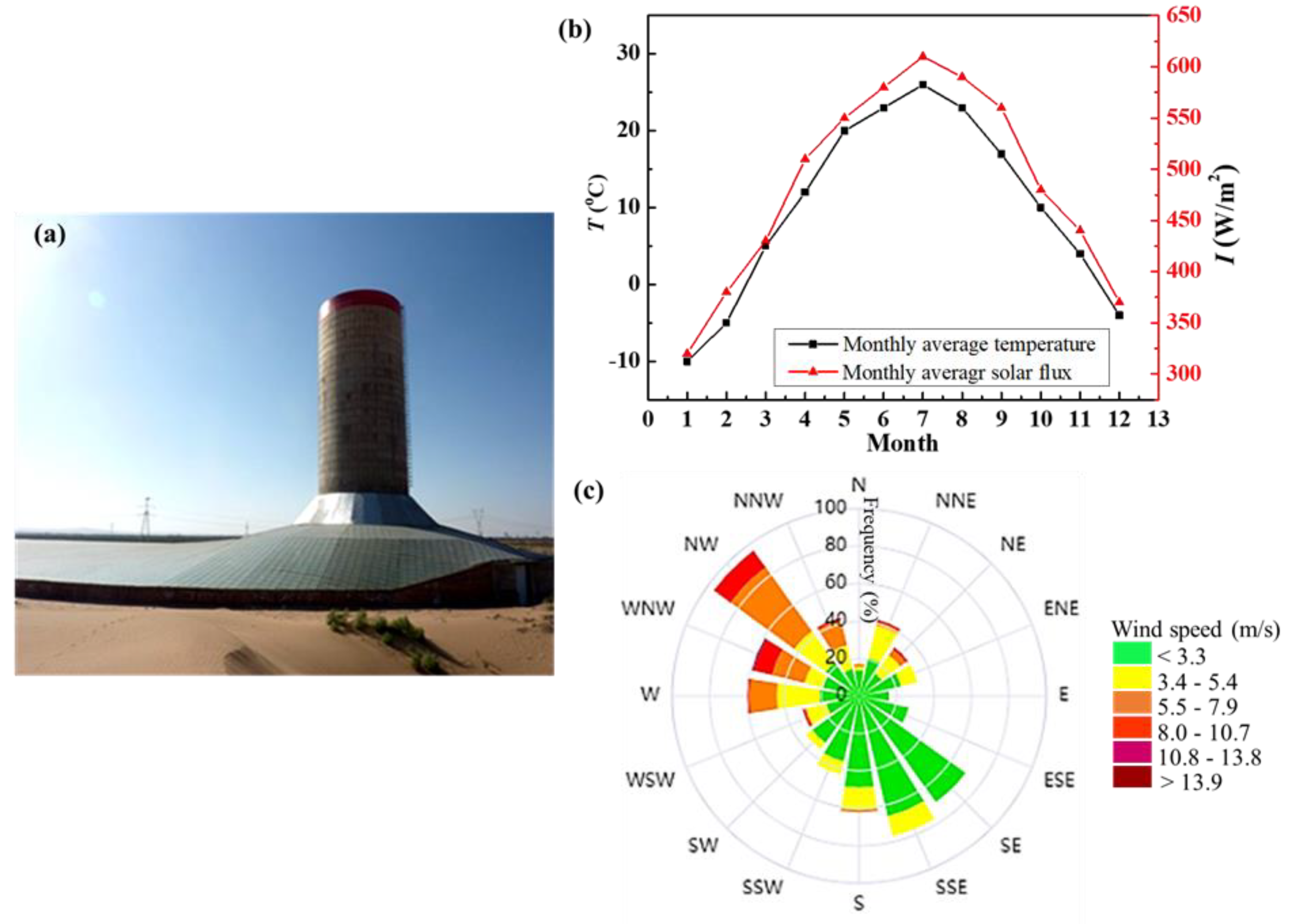
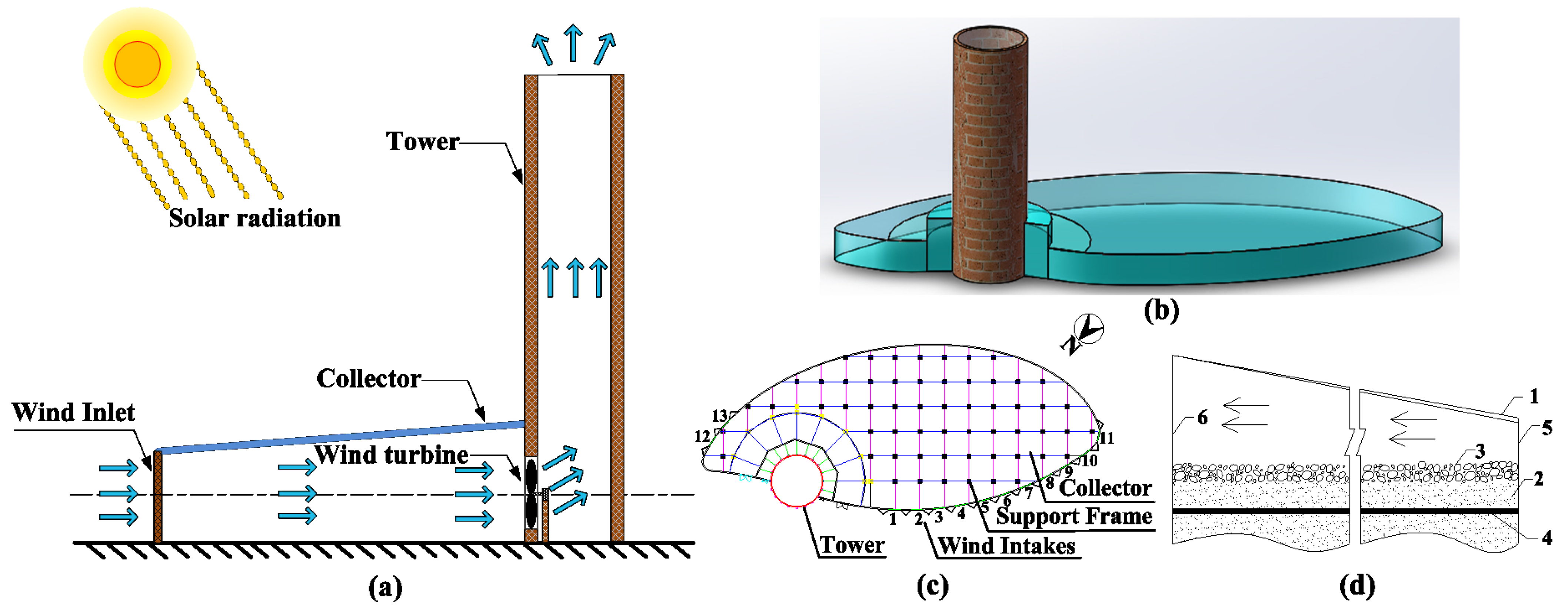
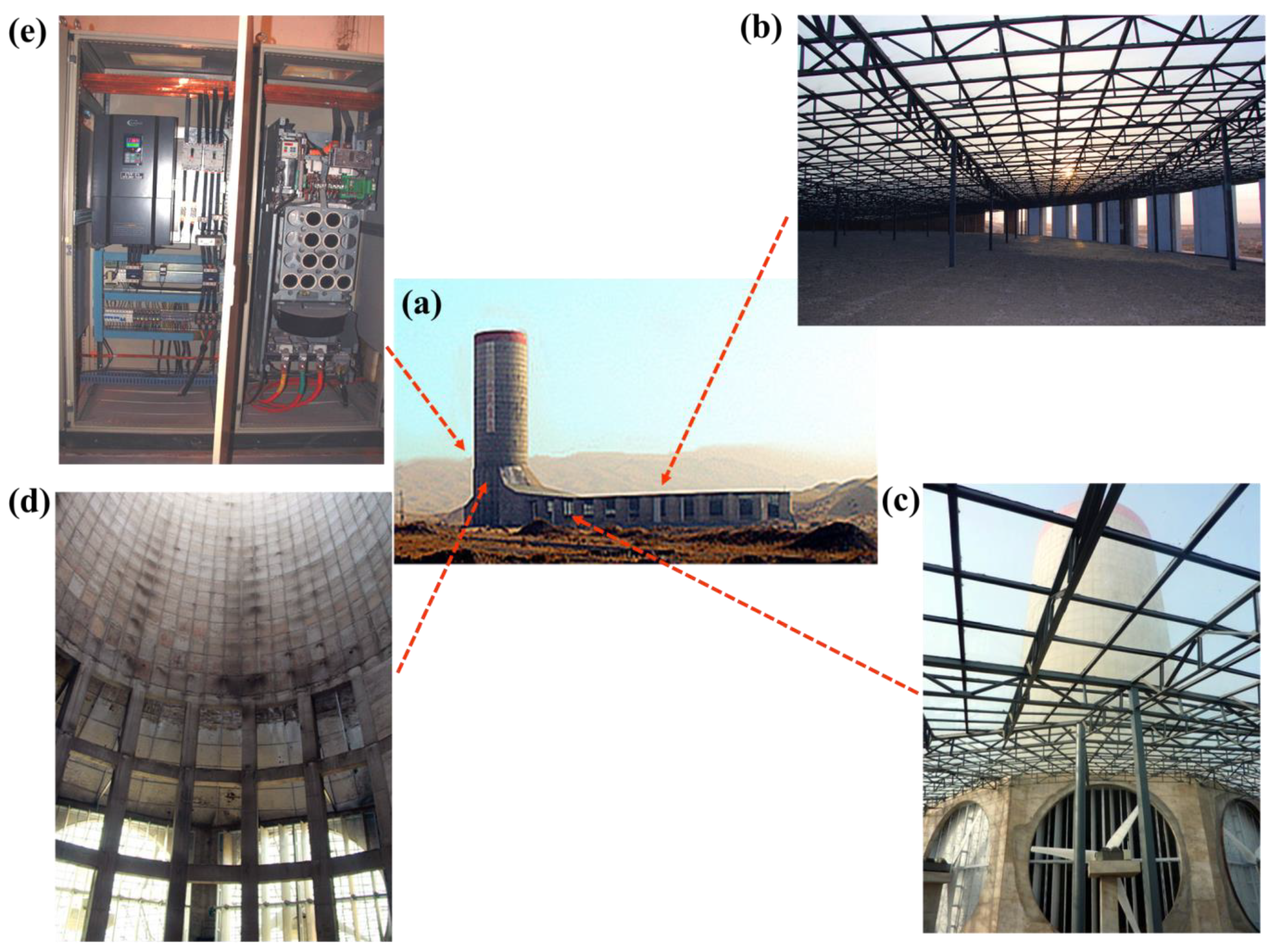

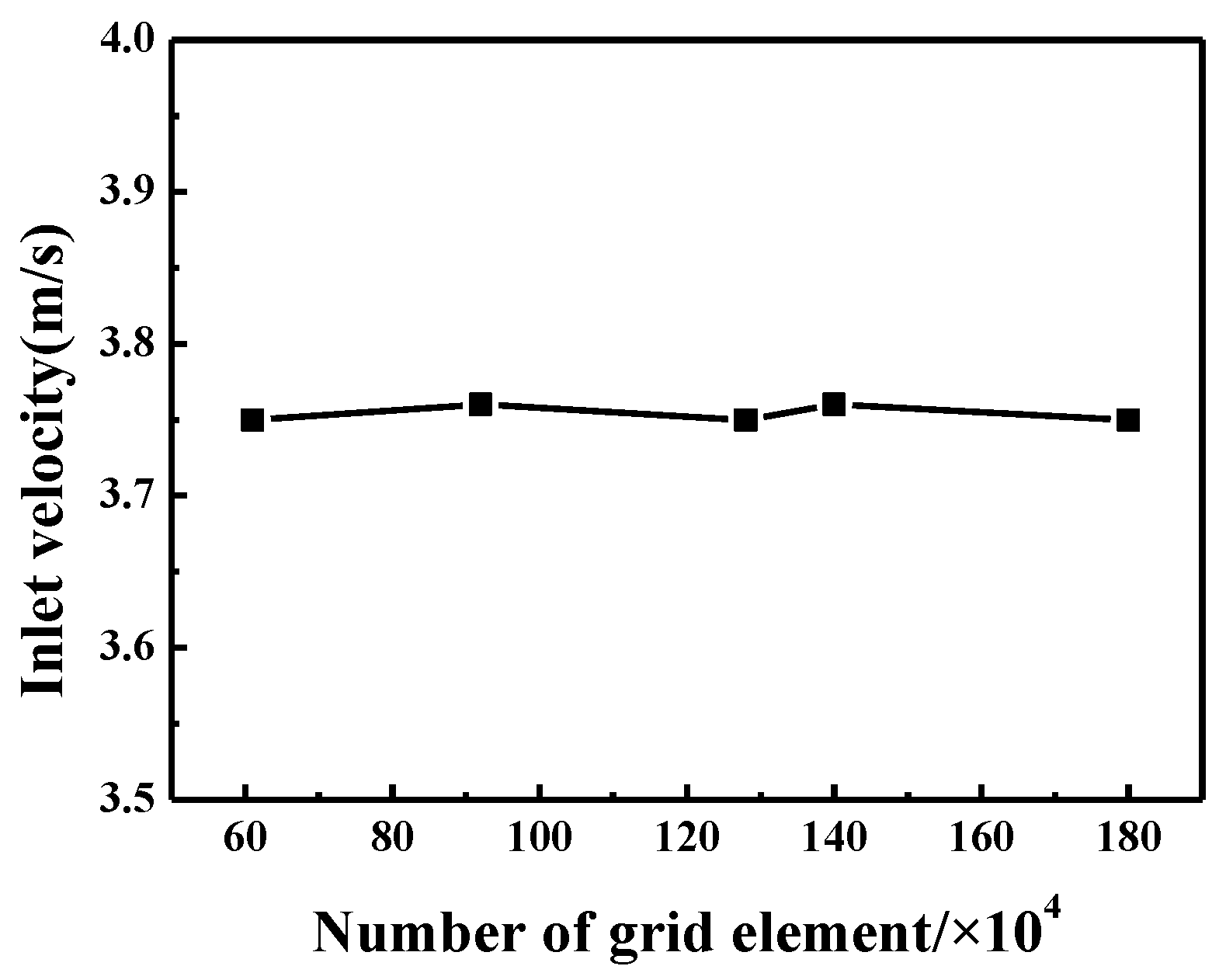
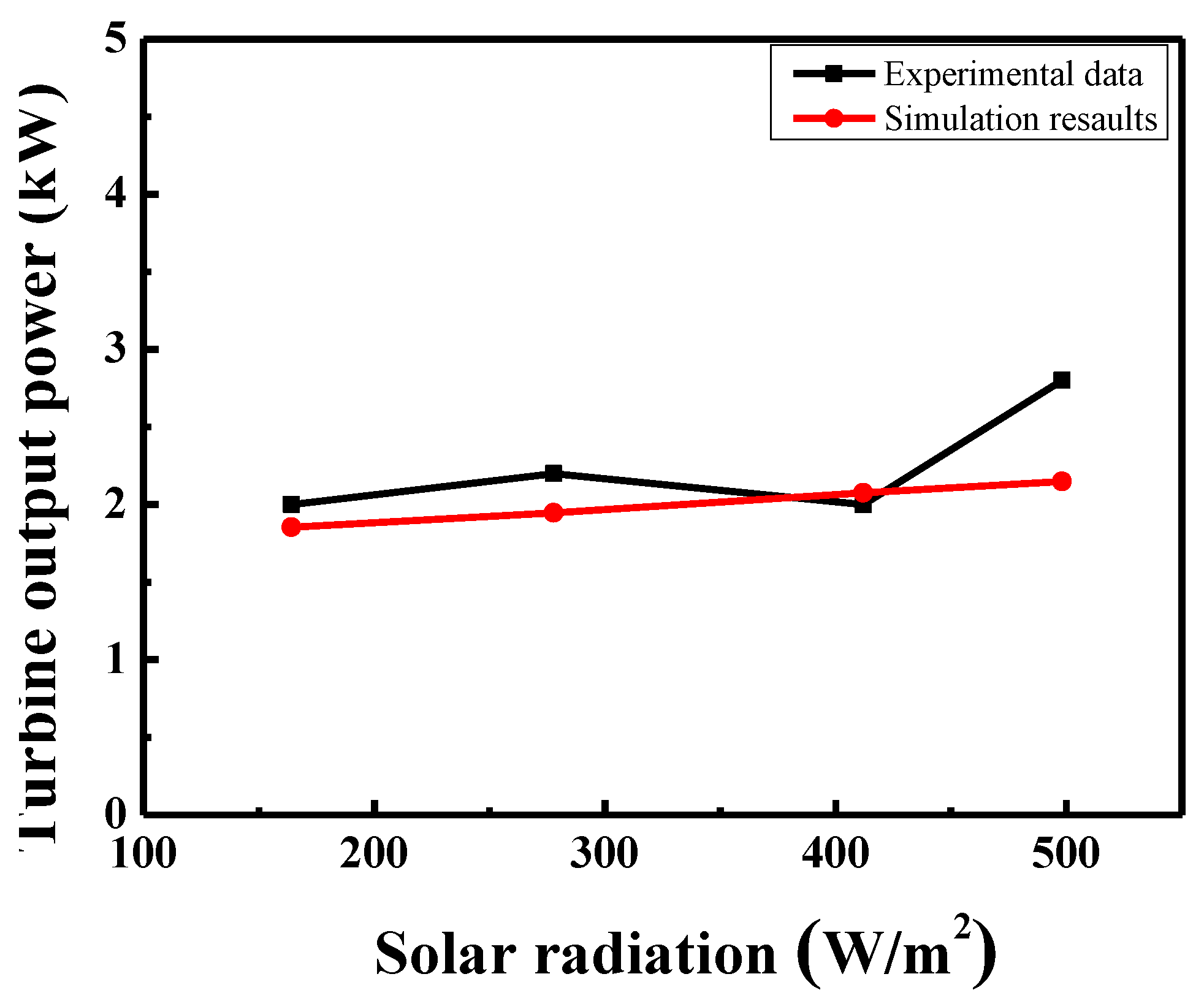

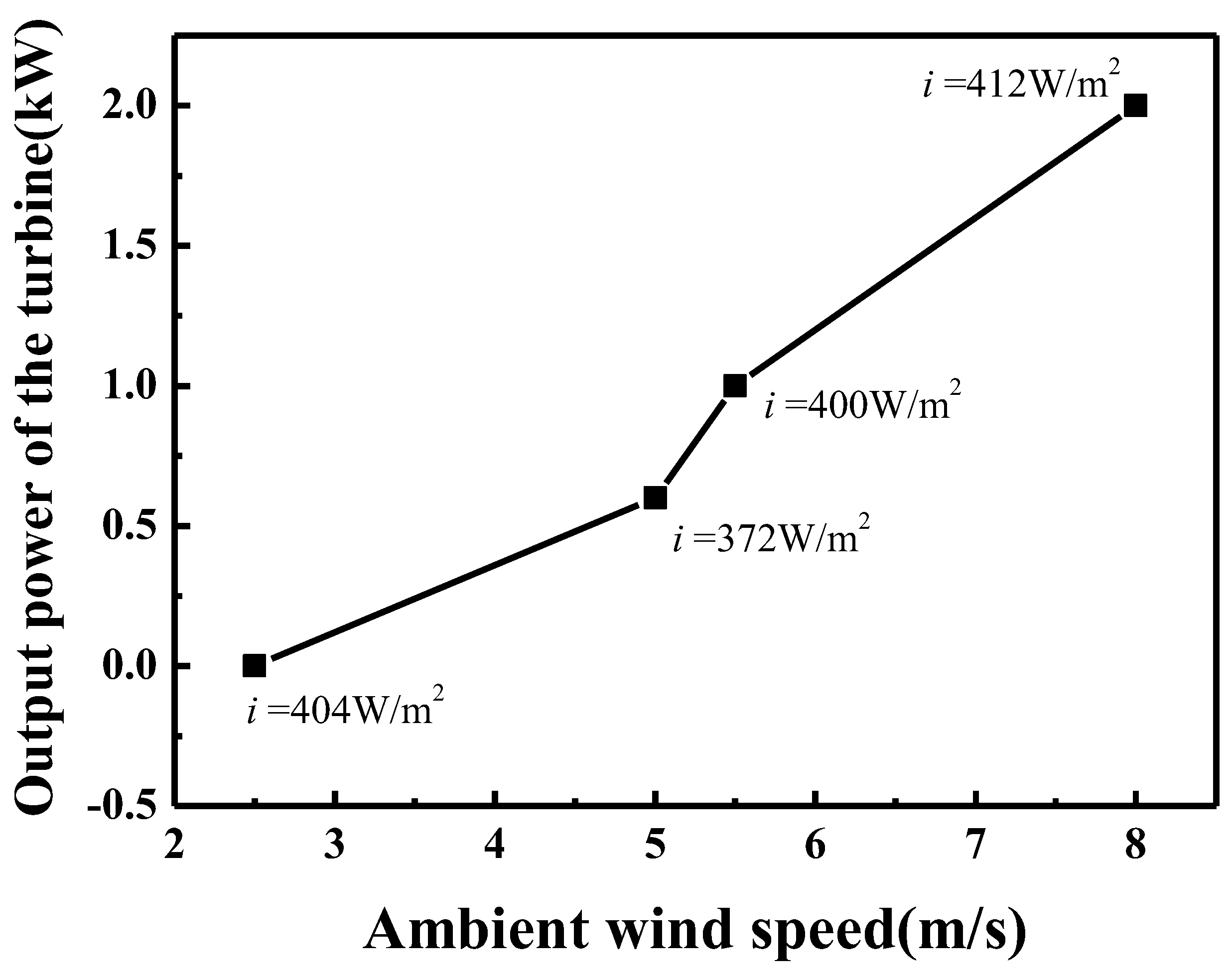
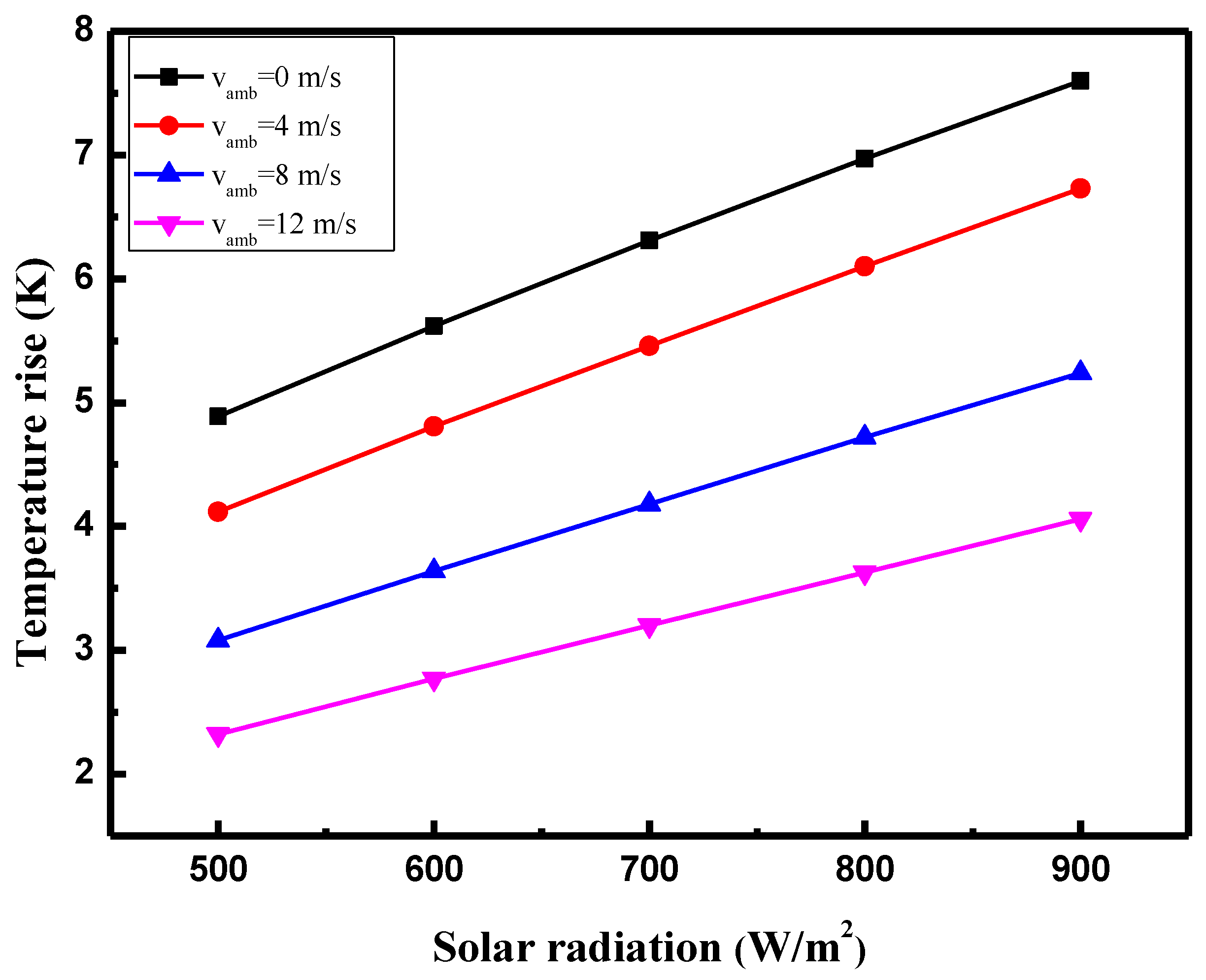
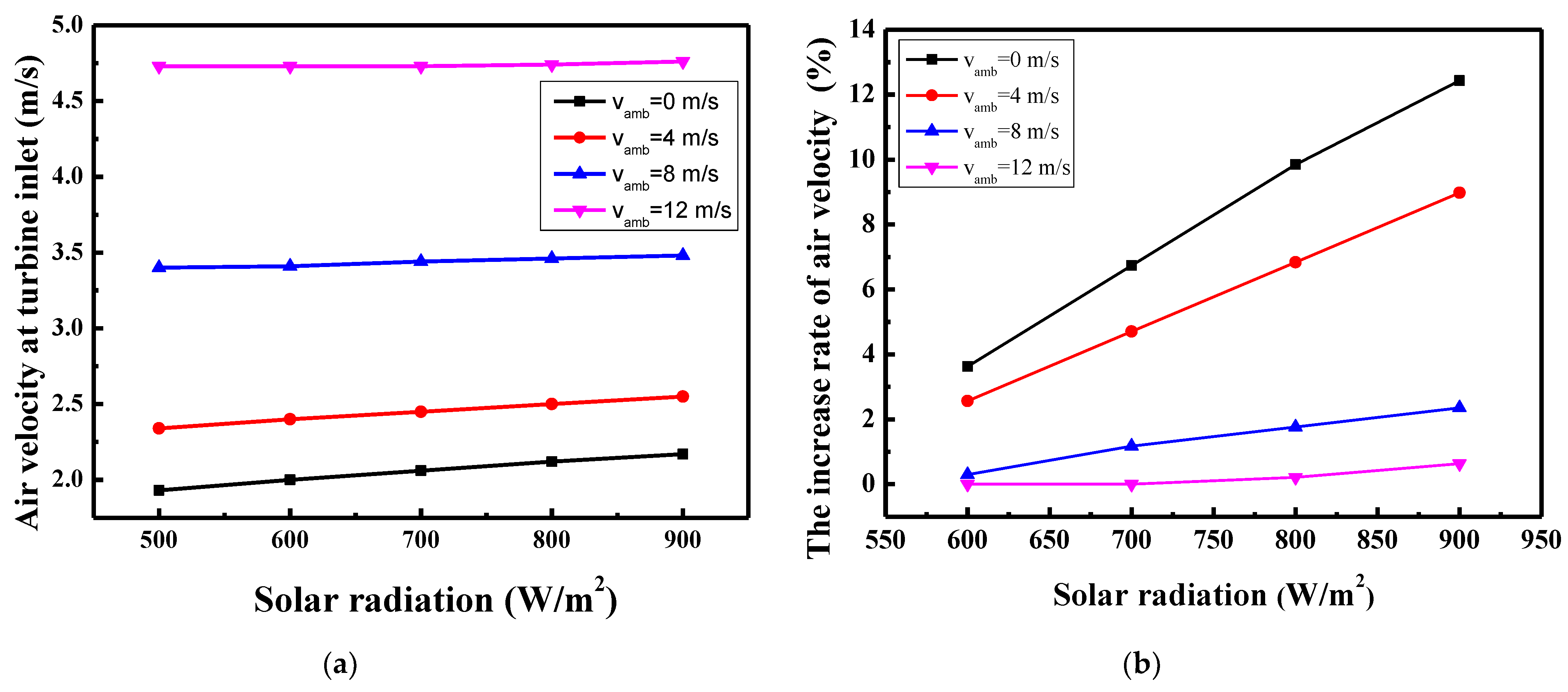

| Place | Type | Description |
|---|---|---|
| Bottom of the collector | Heat flux | 500–900 W/m2 |
| Surface of the canopy | Wall | T = 293.15 K, |
| Surface of the chimney | Wall | |
| Collector inlet | Pressure inlet | |
| Chimney outlet | Pressure outlet | Atmospheric pressure (1 atm) |
Disclaimer/Publisher’s Note: The statements, opinions and data contained in all publications are solely those of the individual author(s) and contributor(s) and not of MDPI and/or the editor(s). MDPI and/or the editor(s) disclaim responsibility for any injury to people or property resulting from any ideas, methods, instructions or products referred to in the content. |
© 2024 by the authors. Licensee MDPI, Basel, Switzerland. This article is an open access article distributed under the terms and conditions of the Creative Commons Attribution (CC BY) license (https://creativecommons.org/licenses/by/4.0/).
Share and Cite
Wang, Q.; Chen, M.; Ren, L.; Zhan, X.; Wei, Y.; Jiang, Z. Study of a Novel Updraft Tower Power Plant Combined with Wind and Solar Energy. Buildings 2024, 14, 2416. https://doi.org/10.3390/buildings14082416
Wang Q, Chen M, Ren L, Zhan X, Wei Y, Jiang Z. Study of a Novel Updraft Tower Power Plant Combined with Wind and Solar Energy. Buildings. 2024; 14(8):2416. https://doi.org/10.3390/buildings14082416
Chicago/Turabian StyleWang, Qiong, Meng Chen, Longhui Ren, Xinhang Zhan, Yili Wei, and Zhiyuan Jiang. 2024. "Study of a Novel Updraft Tower Power Plant Combined with Wind and Solar Energy" Buildings 14, no. 8: 2416. https://doi.org/10.3390/buildings14082416
APA StyleWang, Q., Chen, M., Ren, L., Zhan, X., Wei, Y., & Jiang, Z. (2024). Study of a Novel Updraft Tower Power Plant Combined with Wind and Solar Energy. Buildings, 14(8), 2416. https://doi.org/10.3390/buildings14082416







